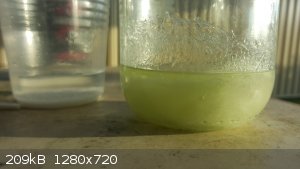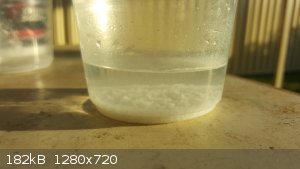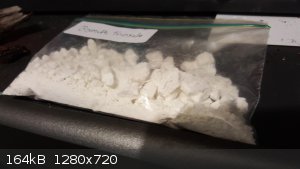toothpick93
Harmless

Posts: 44
Registered: 26-2-2013
Member Is Offline
Mood: No Mood
|
|
Making Bismuth(III) Oxide
i've been filming a few videos lately to do with pyrotechnics and fire and came accross dragon eggs which are a very simple composition which requires
Bismuth Trioxide as the main component I did not have so instead of buying it I decided to make it (in a bit too deep here I think). I must not have
looked deep enough but the videos I watched of Nitric acid reacting with bismuth was slow and needed heating to accomplish anything so I added my
bismuth into the acid and geez it reacted vigorously, I was prepared for something like that I just did not expect it.
I came back the next morning and the solution went from clear to pretty much a saturated solution with what looks to be most of the crystals falling
out of the solution, is this a mixture of Bismuth Nitrate and Bismuth Oxynitrates? When i add the crystals to water the solution turns a cloudy white
and then when I add the cloudy solution to Sodium Hydroxide a white precipitate falls out of the solution. Is this Bismuth(III) Oxide? Is the Bismuth
nitrate hydrolyzing on contact with the water to the oxynitrates and then reacting with the NaOH to form the insoluble Bismuth Oxide?
Bismuth in Nitric Acid

Bismuth solution in water

White precipitate after adding sodium hydroxide

|
|
|
woelen
Super Administrator
        
Posts: 8084
Registered: 20-8-2005
Location: Netherlands
Member Is Offline
Mood: interested
|
|
Your water contains a lot of bismuth nitrate in solution, excess HNO3 and the solid is basic bismuth nitrate, mixed with hydroxde.
If you want to make your oxide, simply dissolve the bismuth in nitric acid and when all of the metal has disappeared, then boil down the liquid. At a
certain point you get a wet paste. Keep heating, drive off water vapor and vapor of nitric acid. Keep heating further and stronger, you get nitric
oxide (brown fumes). After prolonged heating, when the formation of brown fumes ceases, you will have a pale yellow solid, which is quite pure Bi2O3.
Pure Bi2O3 is yellow, not white.
It is a pity that you added NaOH to your solution of bismuth. Now you contaminated your product. The precipitate almost certainly contains quite some
sodium ions as well, it most likely will be impure bismuth hydroxide/nitrate with trapped sodium ions.
|
|
|
MrHomeScientist
International Hazard
    
Posts: 1806
Registered: 24-10-2010
Location: Flerovium
Member Is Offline
Mood: No Mood
|
|
I've made bismuth trioxide by accident when attempting to melt bismuth powder. Instead of melting, the high surface area makes it react with oxygen
and turn into yellow Bi<sub>2</sub>O<sub>3</sub>.
|
|
|
Amos
International Hazard
    
Posts: 1406
Registered: 25-3-2014
Location: Yes
Member Is Offline
Mood: No
|
|
Woelen, if the OP strongly boils the solution dry(with the precipitate still in it), will the basic nitrate lose water and nitrogen dioxide, and the
hydroxide decompose as well to form Bi2O3? Or do you think these compounds will be unresponsive to strong heating? If it works, the sodium compounds
should be able to be removed simply by washing with water.
[Edited on 11-2-2015 by Amos]
|
|
|
woelen
Super Administrator
        
Posts: 8084
Registered: 20-8-2005
Location: Netherlands
Member Is Offline
Mood: interested
|
|
If the OP boils down the solution, then he'll end up with sodium nitrate and bismuth oxide. On further heating it will be amazingly hard to get rid of
the nitrate. It will partially decompose to nitrite but only at very high temperatures. Rinsing with water will not really help. The sodium ions will
be trapped inside the particles of the Bi2O3 and will only partially leach out.
For pyrotechnic purposes, however, the heated product will be useful, I'm quite sure that the crackling effect in dragon's eggs still works fine with
the material which has some sodium ions and nitrate ions left in it.
|
|
|
toothpick93
Harmless

Posts: 44
Registered: 26-2-2013
Member Is Offline
Mood: No Mood
|
|
I understand boiling it down to decompose it is the most easiest way but I do not have access to a hot plate to be able to boil down without breaking
anything. I figured using sodium hydroxide was the easiest way for me at least, I can at least try wash the solid Bi2O3 with a lot of hot water to get
rid of as much sodium nitrate as possible
|
|
|
toothpick93
Harmless

Posts: 44
Registered: 26-2-2013
Member Is Offline
Mood: No Mood
|
|
I decided to use Potassium Hydroxide over Sodium Hydroxide for the reaction. This is the white precipitate I was left with. I thought Bismuth(III)
Oxide is supposed to be yellow? Is it ok that it is white?

|
|
|
HeYBrO
Hazard to Others
  
Posts: 289
Registered: 6-12-2013
Location: 'straya
Member Is Offline
Mood: 
|
|
Quote: Originally posted by toothpick93  | I decided to use Potassium Hydroxide over Sodium Hydroxide for the reaction. This is the white precipitate I was left with. I thought Bismuth(III)
Oxide is supposed to be yellow? Is it ok that it is white?
|
Why don't you try it in the composition you're interested in? If it doesn't work try again with the suggestions posted by woelen et al.
|
|
|
toothpick93
Harmless

Posts: 44
Registered: 26-2-2013
Member Is Offline
Mood: No Mood
|
|
I'm certain it is Bismuth Trioxide, what else could it be. I cant make the composition yet as i'm working to make Nitrocellulose Lacquer next. I cant
really test it as everything I do is also made into a video for youtube. I will just have to wait until it is time to make it
|
|
|